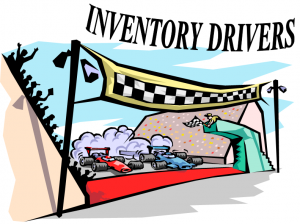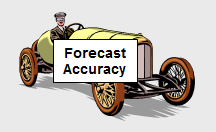 Welcome back to the ongoing series about Inventory Drivers. Since the last two blogs talked about accuracy I thought I would continue the trend and talk about Forecast Accuracy. I realize most people think this is an oxymoron since the guiding principle in most forecast programs is that the forecast is always wrong. Fortunately we really don’t care that it is wrong. What we really care about is “how wrong is it?” This is a question that most forecasters get really passionate about because even though we know perfection is not possible, deep down we are convinced that if we can just get enough information and a fast enough program we can get it right. We KNOW we can’t but we still want to. Actually, from a company point of view, accuracy should be a matter of Return on Investment. If we spend more money on increasing accuracy than we get back in cost saving from that increased accuracy then we are wasting the company’s money. The important thing to keep in mind here is that an accurate forecast is not required for proper inventory control. That is why we have things like safety stock. Admittedly, the less accurate the forecast is, the more safety stock that is required but that is all just a matter of applying the right formula and having a clear definition of just how much risk the organization is willing to accept. That does not mean that a forecast is not important. It is critically important for a number of reasons from inventory planning, to financial planning, to production planning… Notice a trend there? Forecasts are important to the PLANNING process not the input / output control. Plans, just like forecasts, are inherently unstable. To misquote a little bit – No plan survives contact with reality. Once you have a plan it is necessary to monitor how close reality is to the plan and adjust accordingly. How often and quickly you do this will dramatically influence how successful you are at controlling your inventory. Both planning and forecasting are about RISK CONTROL and it is the need for lower risk that leads to the higher inventory levels. Increased forecast accuracy (to a point) leads to better plans, higher customer service, lower risk and eventually to lower inventory levels.
Welcome back to the ongoing series about Inventory Drivers. Since the last two blogs talked about accuracy I thought I would continue the trend and talk about Forecast Accuracy. I realize most people think this is an oxymoron since the guiding principle in most forecast programs is that the forecast is always wrong. Fortunately we really don’t care that it is wrong. What we really care about is “how wrong is it?” This is a question that most forecasters get really passionate about because even though we know perfection is not possible, deep down we are convinced that if we can just get enough information and a fast enough program we can get it right. We KNOW we can’t but we still want to. Actually, from a company point of view, accuracy should be a matter of Return on Investment. If we spend more money on increasing accuracy than we get back in cost saving from that increased accuracy then we are wasting the company’s money. The important thing to keep in mind here is that an accurate forecast is not required for proper inventory control. That is why we have things like safety stock. Admittedly, the less accurate the forecast is, the more safety stock that is required but that is all just a matter of applying the right formula and having a clear definition of just how much risk the organization is willing to accept. That does not mean that a forecast is not important. It is critically important for a number of reasons from inventory planning, to financial planning, to production planning… Notice a trend there? Forecasts are important to the PLANNING process not the input / output control. Plans, just like forecasts, are inherently unstable. To misquote a little bit – No plan survives contact with reality. Once you have a plan it is necessary to monitor how close reality is to the plan and adjust accordingly. How often and quickly you do this will dramatically influence how successful you are at controlling your inventory. Both planning and forecasting are about RISK CONTROL and it is the need for lower risk that leads to the higher inventory levels. Increased forecast accuracy (to a point) leads to better plans, higher customer service, lower risk and eventually to lower inventory levels.
One other quick thought before we leave this – WHO in your organization is responsible for generating the forecast. I would suggest this is the responsibility of the sales department. They do not need to do all the calculations and details of the forecast process but they are the people in your organization that are dealing with your customers decision makers and therefore have the best chance of finding about about potential changes before they happen. A forecast built solely on historical data will never catch potential game changing issues until after the fact which always leaves you reacting to everyone else. It is like driving using only the rear view mirror. You are OK so long as the road is straight but as soon as there is a curve in the road you end up in the ditch. Those curves represent changes from historical norms such as changes to customer orders. Your sales force is in the best position to identify the “curves” before they put your processes “in the ditch”. The problem of course, is that most sales people are not “fond” of forecasting as that is not their primary job (which is to sell product). To counteract that I have always given them three instructions about forecasting:
– Sort the customer or product by forecast accuracy and then start with the worst one and move down the list. The more accurate ones are already good and working on them will not help as much as working on the worst one
– Do not spend more than three hours per month doing the forecast. They may not get through every forecast but hopefully the ones they do will be further down the list next month so rotation will eventually bring each customer to the set that get touched. This is sort of like continuous improvement. Over the long run you can get amazing results.
– If you must guess, then guess high. It is generally less expensive to have a little extra stock than to run out and short a customer. While saving money is always a good point the sales force will be more in favour with the point of not shorting a customer.
Enjoy thinking and talking to your friends and co-workers about this, especially what it means for your organization. I would love to hear back on your (and their) thoughts on this topic


You must log in to post a comment.